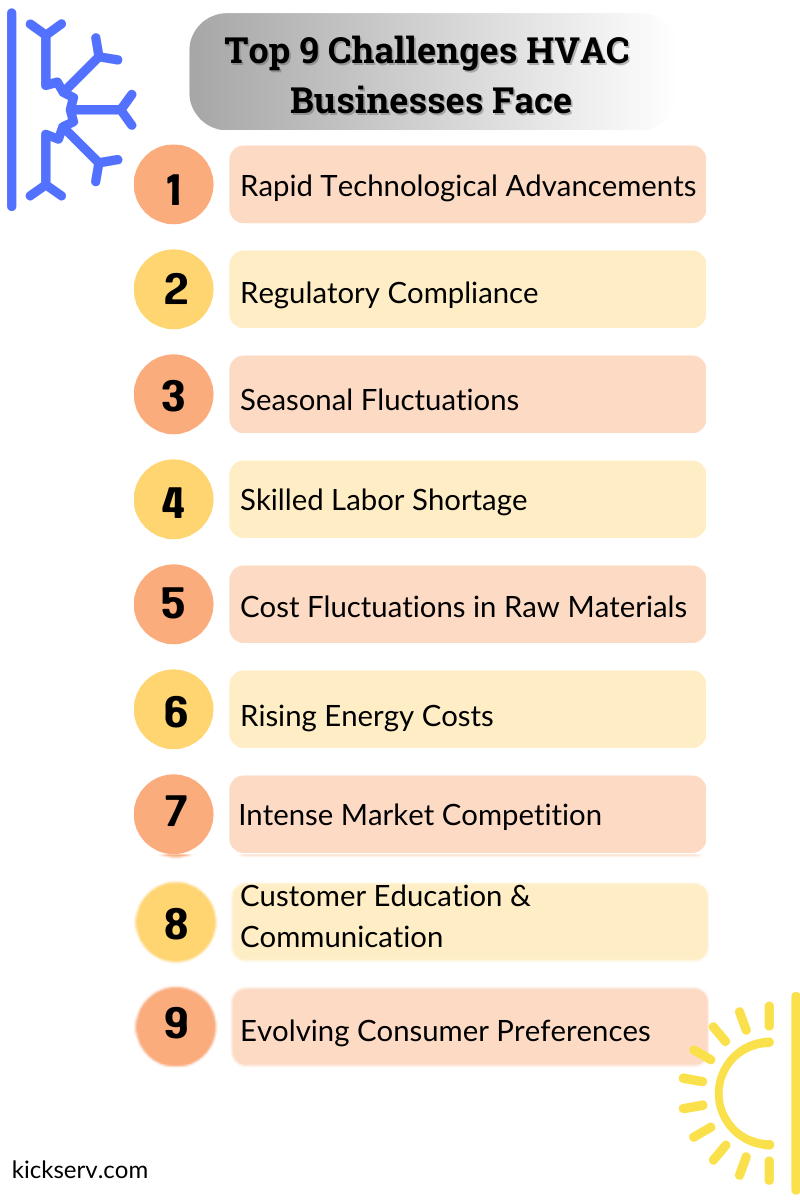
Top 9 Challenges HVAC Businesses Face
Top 9 Challenges HVAC Businesses Face
Introduction
The Heating, Ventilation, and Air Conditioning (HVAC) industry plays a crucial role in keeping comfort and indoor air quality for homes, businesses, and industrial spaces.
While the demand for HVAC services continues to rise, HVAC businesses face a myriad of challenges that can affect their operations, growth, and overall success.
In this article, we will explore the top 9 challenges HVAC businesses commonly face and discuss potential strategies to overcome them.
1. Rapid Technological Advancements
One of the foremost challenges facing HVAC businesses is the rapid pace of technological advancements. As new HVAC tools and technologies appear, businesses must invest in training their workforce to keep up with the latest developments. Additionally, the cost of upgrading equipment and staying technologically relevant can be a significant burden for smaller HVAC businesses.
Solution: Continuous education and training programs for technicians, coupled with strategic partnerships with manufacturers, can help HVAC businesses stay abreast of technological advancements in addition to keeping a talented team. Implementing a phased approach to equipment upgrades can also ease the financial strain.
2. Regulatory Compliance
The HVAC industry is subject to a complex web of regulations, codes, and standards that vary by region. Staying compliant with these regulations is essential, but it can be challenging for HVAC businesses to navigate the ever-changing landscape of environmental regulations, safety codes, and energy efficiency standards.
Solution: Setting up a dedicated compliance team and staying engaged with industry associations can help HVAC businesses stay informed about regulatory changes. Investing in technology that automates compliance tracking and reporting can also streamline the process.
3. Seasonal Fluctuations
HVAC businesses often face seasonal peaks and valleys in demand. The demand for heating services spikes in the winter, while air conditioning services are in high demand during the summer. Managing workforce fluctuations, keeping cash flow during slow seasons, keeping a HVAC technician salary, and preventing burnout during busy periods are ongoing challenges for HVAC businesses.
Solution: Diversifying services, such as offering maintenance plans and indoor air quality assessments, can help mitigate the impact of seasonal fluctuations. Creating a flexible workforce through cross-training technicians for both heating and cooling services can also improve operational efficiency.
4. Skilled Labor Shortage
Like many home service businesses, the HVAC business is grappling with a shortage of skilled technicians. As experienced technicians retire, there is a growing gap in the workforce that is challenging to fill. Recruiting and keeping skilled workers is a constant struggle for HVAC businesses.
Solution: HVAC businesses can address the skilled labor shortage by implementing comprehensive training programs, partnering with technical schools, and offering a competitive HVAC technician salary and benefits. Creating a positive work culture that values employee growth and development can also contribute to higher retention rates.

5. Cost Fluctuations in Raw Materials
The cost of raw materials, such as steel, copper, and refrigerants, can be unpredictable, changing the overall cost of HVAC projects. Fluctuations in raw material prices can affect profit margins and pose financial challenges for HVAC businesses.
Solution: Setting up strategic partnerships with suppliers and negotiating long-term contracts can supply stability in the face of raw material price fluctuations. Additionally, exploring alternative materials and energy-efficient technologies can help mitigate the impact of rising costs.
6. Rising Energy Costs
Escalating energy costs are a concern for both HVAC businesses and their clients. Energy-efficient HVAC systems are increasingly in demand, but the first investment can be a barrier for some customers. Balancing the need for energy efficiency with cost considerations presents a significant challenge for HVAC businesses.
Solution: Educating customers about the long-term cost savings associated with energy-efficient systems and exploring financing options can help overcome resistance to higher upfront costs. Offering energy audits and showing the return on investment of energy-efficient upgrades can also be persuasive.
7. Intense Market Competition
The HVAC industry is highly competitive, with many businesses vying for the same pool of customers. Standing out in a crowded market and keeping loyal clients in the face of aggressive competition is a perpetual challenge for HVAC businesses, especially those without a dedicated HVAC marketing strategy.
Solution: Developing a strong brand identity, using positive customer reviews, and supplying exceptional customer service can set HVAC businesses apart from the competition. Offering unique services, such as smart home integration or innovative maintenance programs, can also attract and keep customers.
8. Customer Education and Communication
Educating customers about the importance of regular HVAC maintenance, energy-efficient upgrades, and the value of quality systems can be challenging. Misconceptions about HVAC systems and services can lead to customer dissatisfaction and hinder the growth of HVAC businesses.
Solution: Implementing a robust online customer education program, including informative content on the company website, social media, and regular newsletters, can help bridge the gap in understanding while also acting as built-in HVAC marketing. Supplying transparent pricing and clear communication about the benefits of HVAC services can build trust and enhance customer satisfaction.
9. Evolving Consumer Preferences
Consumer preferences in HVAC businesses are evolving, with an increasing focus on sustainability, smart home integration, and energy efficiency. HVAC businesses need to stay attuned to these shifting preferences and adapt their offerings to meet the changing demands of the market.
Solution: Conducting market research, staying informed about industry trends, and regularly updating service offerings to align with consumer preferences can help HVAC businesses stay relevant. Engaging with customers through surveys and feedback mechanisms can supply valuable insights into evolving preferences.
Conclusion
The HVAC industry is not without its challenges, but proactive strategies and a commitment to continuous improvement can position businesses for success. By addressing issues such as new HVAC tools and technology, regulatory compliance, seasonal fluctuations, and skilled labor shortages, HVAC businesses can navigate the complexities of the industry and thrive in a competitive market. Embracing innovation, staying customer-focused, and fostering a positive work culture are essential elements in overcoming the challenges that HVAC businesses face, ensuring long-term sustainability and growth in a dynamic and evolving industry.
Want more tips to position your HVAC business for success? Subscribe to our blog to get our articles, guides, and How-To's delivered right to your inbox.
Never miss a post.
Get notified of new content